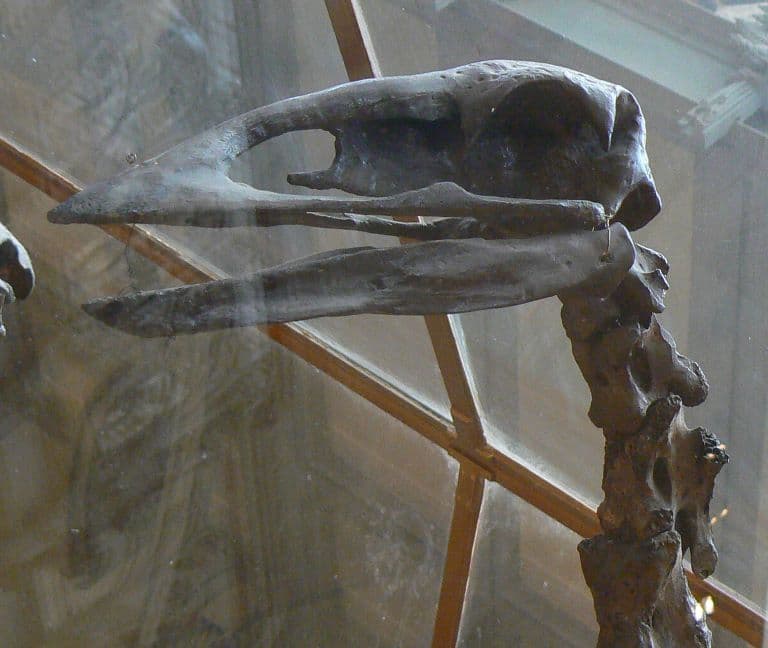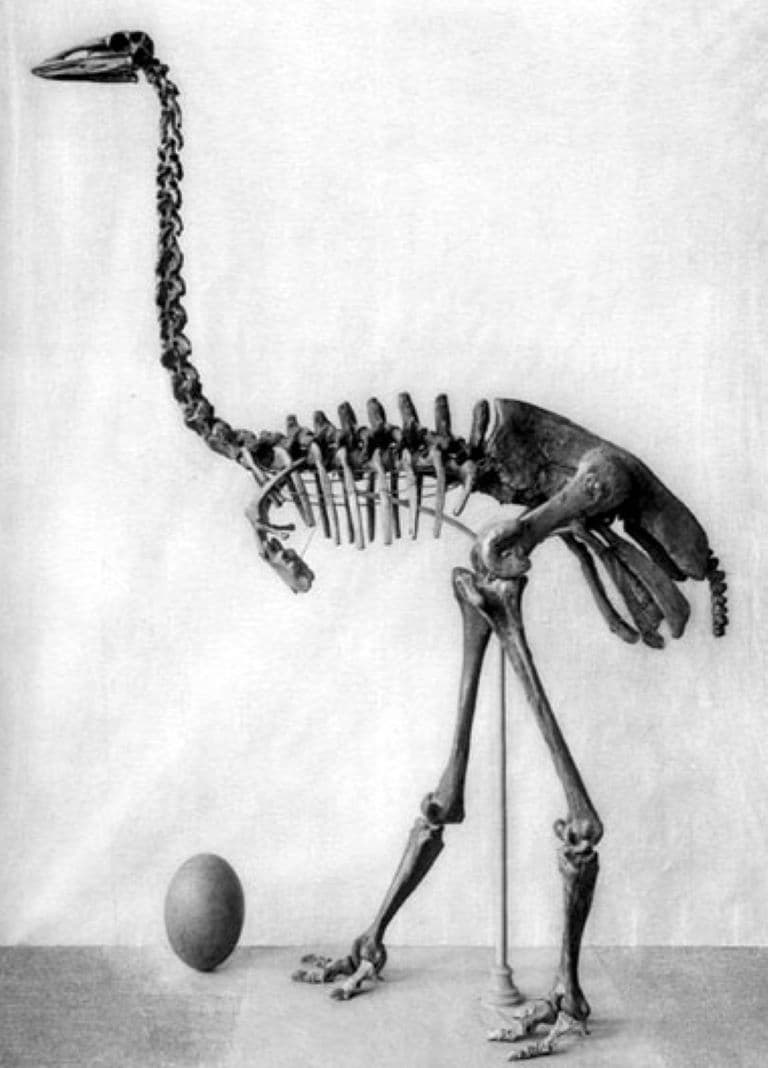Elephant Bird Profile
If we ever needed a reminder that birds are dinosaurs, a three-metre, 700k ostrich would be a good one. As recently as 1000 years ago, such animals shared their habitat with modern humans, and what a sight they must have been!
Elephant birds were walking legends, and well worthy of the status!

Elephant Bird Facts Overview
| Habitat: | Forests |
| Location: | Madagascar |
| Lifespan: | Unknown |
| Size: | 3m (9.8ft) tall |
| Weight: | Possibly more than 700kg |
| Colour: | Unknown |
| Diet: | Likely fruits |
| Predators: | None |
| Top Speed: | Unknown |
| No. of Species: | 5-10 |
| Conservation Status: | Extinct |
These huge ratities roamed the vast island of Madagascar until around 1000 years ago, and despite their fearsome size, were thought to feed on fruits.
They have the largest egg of any vertebrate, many of which still litter the beaches of the island today, and were probably prized by the first human visitors to the island around 10,000 years ago.
Still, little is known from the fossil record, and there’s so much more archaeological work to be done to determine how they got there, why they disappeared, and what happened to the humans who used to live with them.
Interesting Elephant Bird Facts
1. Another Madagascan rarity
Madagascar is an exceptional place. Despite being an African island, it evaded human discovery throughout most of our history, only ‘recently’ discovered around 10,000 years ago. And while it is an island, it’s enormous: one of the largest on Earth.
This vast, isolated and relatively undisturbed habitat led to outstanding diversity and species evolved that do not exist anywhere else. In fact, 95% of the mammals and 98% of the reptiles found on the island are endemic species, unique to Madagascar.
Elephant birds, thought to be distantly related to another extinct giant, the New Zealand Moa, were one of these endemic species, and we are still discovering the extent of their diversity today.
Madagascar separated from the mainland around 150 million years ago, likely long before the elephant bird evolved, which means it probably flew there as an ancestral species and evolved flightlessness over time, independently of their living relatives.
Currently, Madagascan fossil records are very limited, so there’s still a lot to discover about the evolutionary history of this legendary bird.

2. They may have inspired legends
And legendary they became, as famous explorer Marco Polo in the 13th century claimed to have seen a Roc, the mythical bird from various mythologies, said to be able to eat elephants and other large beasts and fly off with them.
Marco Polo said of the Roc:
“To feed, it will seize an elephant in its talons and carry him high into the air, and drop him so that he is smashed to pieces.”
And while it’s said that he both visited and named Madagascar, there’s quite a bit of evidence to suggest this was a bit of a misunderstanding at best, and a bit of a naughty fib at worst. Meanwhile, he claimed to have found such a bird in Madagascar, bringing the legend of the Roc back to Europe. 1
3. Even their babies were thicc
Today’s heavy-set, flightless running birds known as ratites are pretty impressive animals. Ostriches, for example, have dense, thick leg bones and terrifying claws at the end of them, and they’re more than capable of both carrying and kicking a fully-grown person with tremendous power.
Elephant birds put these monsters to shame. Even before they were born, their bones were denser and thicker than any extant equivalents, suggesting immense power and a level of independence straight after hatching.
The eggs alone were thought to be around 10kg, almost ten times the weight of a modern ostrich egg!
These eggs were so big they were used by early settlers as bowls and would likely have been able to feed several people. 3.[/note]
4. Yet, they’re more closely related to the Kiwi
Of all the ratites, the Kiwi is likely the last you’d think of. Kiwis are the smallest of the lot, so there’s an irony that they are the most closely related to the largest.
Like the Kiwi, elephant birds had small, atrophied eyes, suggesting they weren’t used all that much, and implying a more nocturnal foraging strategy.
Both birds shared a common ancestor around 50 million years ago, much more recently than the seemingly more fitting link between ostriches and elephant birds.
This ancestor may have been a chicken-sized, flying bird that flew all over the world and settled on the separate islands. Evolution favoured flightlessness in both cases, but the birds grew enormous in Madagascar, while in New Zealand they remained small.
5. They grew to be the largest bird ever
So far, we don’t have any examples of birds from the fossil records that are larger than the biggest species of Elephant bird, Aepyornis maximus. They certainly have the largest eggs we know of, and from the skeletons, we can tell they grew to around three meters tall.
Plenty big and powerful enough to cause you some damage, but this size may have come as a very recent development, evolutionarily speaking.
While the lineage was likely present on the island for tens of millions of years, there is evidence that a divergence in species and possibly even the giganticism that makes them such an iconic example of extinct birds happened only in the last 1.4 million years as the climate cooled. 4
6. Then they went extinct
Elephant birds died out fairly recently, and there’s not a lot of evidence as to why. There are reasonable speculations – on account of this happening pretty much everywhere else on Earth – that the arrival of humans and agriculture had something to do with it, but this has not been strongly confirmed either way.
We’re not even sure when the bird went extinct; shells of elephant bird eggs are still prevalent among the dunes of the Madagascan coast, and most estimates put the extinction at around 1000 years ago, around the time European settlers arrived and did what European settlers do.
But there are common records of such birds by sailors and explorers that date much more recently. 5
7. Their bones are used to date the discovery of the island
Until recently, it was thought that Madagascar was first visited by humans between 2000 and 4000 years ago, but recent discoveries of elephant bird bones with cut marks on them date back around 10,000 years ago.
This gives us a new insight into the historical record of human migrations and also hints at the reason why these huge animals went extinct. It remains a mystery where these mysterious humans disappeared to. 6
Elephant Bird Fact-File Summary
Scientific Classification
| Kingdom: | Animalia |
| Phylum: | Chordata |
| Class: | Aves |
| Order: | Aepyornithiformes |
| Family: | Aepyornithidae, Mullerornithidae |
Fact Sources & References
- “WAS MARCO POLO A GREAT EXPLORER OR A LIAR?” .
- Marek Lukaszewicz (2009), “The Ostrich (Struthio camelus) Egg–a Safety Seat in the Time Vehicle”, Turkish Journal of Veterinary and Animal Sciences 33(1) 2 “Elephant Bird Egg”, Past & Present Science and Nature Store.
- Gifford Miller (2023), “Extinct elephant birds were 3 metres tall and weighed 700kg. Now, DNA from fossil eggshells reveals how they lived”, The Conversation.
- Kai McNamee (2023), “Giant eggshells reveal the secrets of Madagascar’s elephant birds”, npr.
- (2018), “Humans Were Present in Madagascar 6,000 Years Earlier Than Believed”, Stony Brook University.
